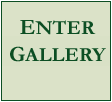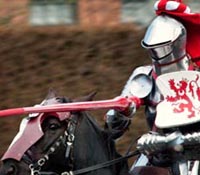Having lost
all of Monday putting last week's Painting Diary on to web-site
and catching up with correspondence, I am keen to get on with
some painting when I get into my studio first thing Tuesday
morning. As I said at the end of last week, I want to spend
some time on the central figure of Anthony, Count de la Roche,
so I have all my tournament armour reference to hand to help
me finalise his appearance. Working upwards from his feet, I
double check his proportions and stance, and 'draw' the more
complicated areas such as the poleyn (knee) with thin, dark
paint, before blocking in areas of tone with a bigger brush.
This takes quite a bit of time because I am constantly checking
my reference and making important decisions about the exact
form and style of the armour he is wearing.
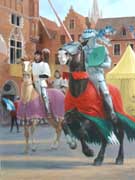
Click
image to enlarge |
The legs
are fairly plain but have some cusping along the edges of the
articulating lames of the poleyn - typical of Flemish armours
of this period. The most obvious difference between this armour
and a 'battle' harness are the specialist jousting pieces; the
'frog-mouth' helm, manifer (long gauntlet protecting the entire
lower left arm), and the large rondell hanging over the right
armpit. By this period, the shield had ceased to be used in
battle, but a small 'targe' continued to be worn for the joust,
in this case tied to a staple on the breastplate and giving
added protection to the target area.
I now move
on to the horses caparison and give this another coat of paint,
refining the folds and shadows/highlights. Eventually this will
be covered in an intricate gold pattern, as de la Marche describes
one of the 'Grand Bastard's' (many) caparisons as being of crimson
cloth-of-gold, with a white, dagged, border.
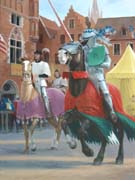
Click
image to enlarge |
You could
be forgiven for thinking that progress has really slowed down,
but at this stage of the painting I can spend hours working
away - adding brushstrokes, building up colours and detail -
without, at first glance, it looking like much has been achieved.
I spend some more time on the yellow pavilion and add detail
to the flag on top; refine the squire's face; define the background
squire;
indicate another flag; etc. etc.
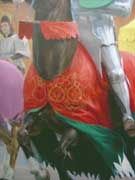
Click
image to enlarge |
By Friday,
the red paint on the caparison is dry, so I am able to start
working out the cloth-of-gold pattern. This is based on a surviving
fragment of material preserved in the V&A, and it follows a
fairly typical design that was very popular in the 15th century.
It is, however, extremely complicated, and I have the added
problem of trying to make it follow the shape of the horse it's
covering. I have
always been amazed at how the early Flemish painters managed
to paint these complex designs in such detail, but if I was
to achieve that level of sharpness, I think it would look unnatural
and static. However, I do want to accurately represent the look
of the fabric, so will show the central part in focus and then
soften it as it goes away round the horse. By lunchtime I have
managed to establish only a small part of the pattern, and this
still needs further work, but I am going cross-eyed so I spend
the rest of the day working on other areas of the canvas. However,
I am happy with the way the fabric is beginning to look, and
am confident it will look suitably opulent when it is finished.
I will include another detail picture of this area of the painting
when I have added more highlights and shadows to really make
the gold areas shimmer. Display was a very important part of
medieval society, and using such costly fabrics, especially
in the quantities required for horse caparisons, was guaranteed
to impress contemporaries. De la Marche's account of this tournament
often seems more concerned with recording exactly what wealth
was on show, rather than the outcome of the jousts themselves!
Next week
I will spend as much time as I can at the easel, but I will
also be preparing for my annual exhibition at the Tewkesbury
Medieval Festival next weekend - the 10th/11th July. More information
can be found on the Latest News page - click here - and I look
forward to seeing you there.
Return
to Introduction
Back
to Week 4- Forward to Week
6

